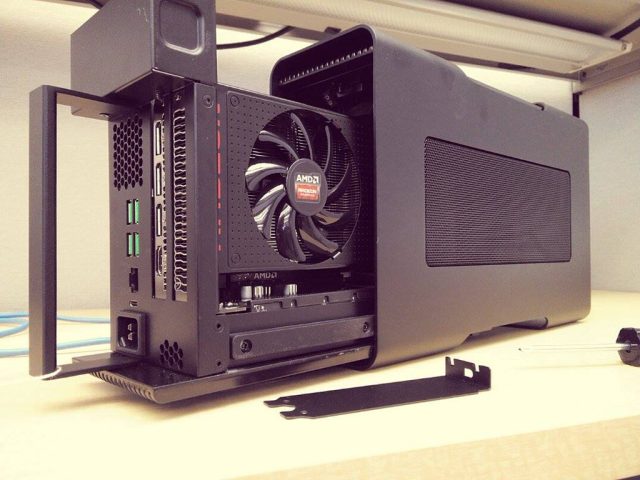
AMD hints that it's working on a new external graphics card solution that promises to be "the answer" to "ultrathin" laptop gaming, according to technical marketing head Robert Hallock.
"Ultrathin notebooks are awesome to carry, but nobody in their right mind would confuse one for a gaming notebook," says Hallock. "But there's still a HUGE appetite for thin notebooks that can game. I also bet there's a bunch of gamers out there who, as they get into their 30s and 40s, wouldn't mind condensing their entire computing life down into one device that does it all... External GPUs are the answer. External GPUs with standardised connectors, cables, drivers, plug'n'play, OS support, etc."
AMD isn't saying what those "standardised connectors" might look like just yet, but Hallock promises that the company will share "more info very soon." With GDC 2016 just around the corner, AMD could opt to discuss its plans there, although a quick scan of the sessions taking place during the conference—which mostly revolve around DirectX 12—reveals little.
Some might argue that an external GPU interface has already been standardised. With the advent of Thunderbolt 3—which uses a USB Type-C connector to deliver up to 40Gbps of bandwidth—laptop makers have been falling over themselves to release external GPU solutions that use the simple plug-and-play connection. In January 2015 Asus unveiled its ROG XG Station 2, which uses a pair of Thunderbolt 3.0 connections to create an external PCI-E x4 socket. Razer has its Core GPU enclosure, which also uses a Thunderbolt 3 connection.
Tellingly, the picture Hallock used to illustrate his point on Facebook was that of a Razer Core.
Still, that's not to say the external GPU is without problems. Despite the convenience of a single connector—one that more devices are starting to feature as standard—the external GPU enclosure itself remains a bulky affair, containing a huge desktop graphics card and an ATX power supply. Future graphics cards from both AMD and Nvidia could dramatically reduce the physical size of the GPU—thanks to innovations like HBM—as well its power consumption, allowing for much smaller power supplies. Standardising components and connectors now before those GPUs arrive could be a smart move.
On the other hand, AMD has tried to standardise the external GPU before—and failed miserably. In 2008 AMD launched its XGH external graphics standard, which essentially just took the pins from PCIe slot and passed them through to an external connector (a solution copied by Alienware for its Graphics Amplifier). This was a smart idea at the time, particularly as USB 2.0 and ExpressCard didn't offer anywhere near the amount of bandwidth required for a high-end GPU. Unfortunately, very few laptop manufacturers used XGH, with Fujitsu Siemens' Graphics Booster being one of the rare commercial examples.
Listing image by Robert Hallock
reader comments
103